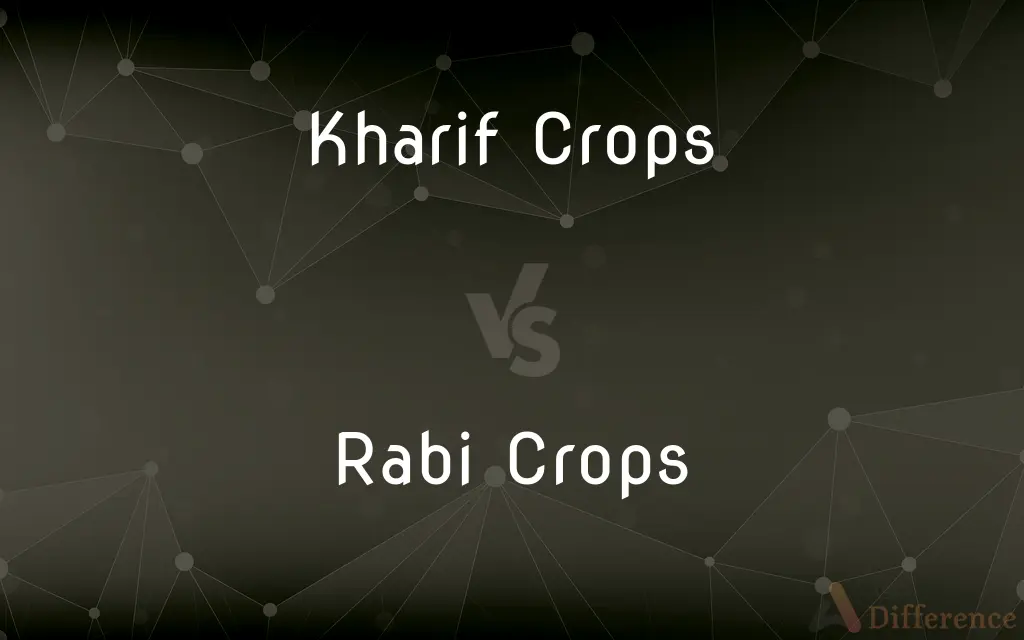Kharif Crops vs. Rabi Crops — What's the Difference?
Edited by Tayyaba Rehman — By Fiza Rafique — Published on December 3, 2023
Kharif crops are sown in the rainy season, while Rabi crops are sown in the winter season.

Difference Between Kharif Crops and Rabi Crops
Table of Contents
ADVERTISEMENT
Key Differences
Kharif Crops and Rabi Crops are integral to India's agricultural cycle. Kharif crops are primarily monsoon-dependent and are sown at the onset of the monsoon season, which typically begins in June and ends in September. These crops are harvested by the end of autumn. On the other hand, Rabi crops are sown during the winter months, particularly from October to December, and harvested during spring, usually between March and May.
The distinguishing factor between Kharif Crops and Rabi Crops is the season in which they are sown. The word "Kharif" in Arabic means "autumn", and these crops are so named because they are harvested in autumn. Rabi, conversely, means "spring" in Arabic. This implies that Rabi crops are harvested in the spring season.
The moisture and temperature levels are also different for Kharif Crops and Rabi Crops. Kharif crops require substantial amounts of water and thrive in a warm environment, which is abundant during the monsoon months in India. Rabi crops require relatively cooler conditions to grow and do not need as much water as Kharif crops.
In terms of produce, rice, cotton, and soybeans are examples of Kharif Crops. Rabi crops, however, include wheat, mustard, and barley. Both these cycles complement each other and provide a continuous supply of crops throughout the year in India.
Comparison Chart
Sowing Season
Rainy (June to September)
Winter (October to December)
ADVERTISEMENT
Harvesting Season
Autumn
Spring
Moisture Requirement
High
Moderate to Low
Temperature Requirement
Warm
Cool
Examples
Rice, Cotton, Soybeans
Wheat, Mustard, Barley
Compare with Definitions
Kharif Crops
Kharif Crops refer to the crops sown during the rainy season.
Rice is a primary Kharif crop in India.
Rabi Crops
Rabi Crops require cooler conditions for growth.
The cool winter months are ideal for sowing Rabi crops like mustard.
Kharif Crops
Kharif Crops need substantial water and a warm climate.
Cotton, a Kharif crop, thrives in the warmth and abundant moisture of the monsoon.
Rabi Crops
Rabi Crops have a moderate to low water requirement.
With less dependency on water, barley thrives as a Rabi crop.
Kharif Crops
Kharif Crops are dependent on the monsoon for their growth cycle.
Farmers rely on the monsoon rains to cultivate Kharif crops like soybeans.
Rabi Crops
Rabi Crops encompass produce such as wheat, barley, and peas.
Peas, a Rabi crop, are commonly found in many dishes during the spring season.
Kharif Crops
Kharif Crops include produce like rice, cotton, and pulses.
Among the Kharif crops, pulses are significant for India's dietary needs.
Rabi Crops
Rabi Crops are those sown during the winter season.
Wheat, a staple in many diets, is a Rabi crop.
Kharif Crops
Kharif Crops are harvested in the autumn season.
As autumn approaches, farmers begin harvesting their Kharif crops.
Rabi Crops
Rabi Crops are harvested during the springtime.
As spring begins, it's time for the Rabi crop harvest.
Common Curiosities
What seasons are associated with Kharif Crops and Rabi Crops?
Kharif crops are associated with the rainy season, while Rabi crops are associated with the winter season.
What's the main difference between Kharif Crops and Rabi Crops?
The sowing and harvesting seasons differentiate them, with Kharif sown in rainy and harvested in autumn, and Rabi sown in winter and harvested in spring.
Are Kharif Crops and Rabi Crops specific to a particular region?
These terms are primarily used in the Indian subcontinent, though the concept of seasonal cropping exists worldwide.
How are Kharif Crops and Rabi Crops vital to the economy?
They provide year-round agricultural output and employment, ensuring a continuous supply of food and agricultural products.
Which requires more water, Kharif Crops or Rabi Crops?
Kharif crops require more water compared to Rabi crops.
How do Kharif Crops and Rabi Crops impact food prices?
Crop yield directly affects food prices; a poor Kharif or Rabi season can result in higher prices.
Do Kharif Crops and Rabi Crops have similar pests and diseases?
No, the pests and diseases often differ based on the crops and the seasons.
Can you give examples of Kharif Crops and Rabi Crops?
Rice and cotton are Kharif crops, while wheat and mustard are Rabi crops.
Are there any crops that don't fall under Kharif Crops or Rabi Crops?
Yes, there are Zaid crops which are grown in the short duration between Kharif and Rabi seasons.
Which crop, between Kharif Crops and Rabi Crops, demands more care in terms of temperature?
Rabi crops are more temperature-sensitive and require cooler conditions.
Why are these crops named Kharif and Rabi?
The names originate from Arabic, with "Kharif" meaning "autumn" and "Rabi" meaning "spring."
What challenges face Kharif Crops and Rabi Crops?
Unpredictable monsoons can affect Kharif crops, while unexpected temperature fluctuations can affect Rabi crops.
What happens if Kharif Crops or Rabi Crops fail?
Crop failure can lead to food shortages, higher prices, and economic challenges for farmers.
How do farmers prepare differently for Kharif Crops versus Rabi Crops?
For Kharif, they prepare for heavy rains and flooding, while for Rabi, they focus on irrigation and frost protection.
Can the terms Kharif Crops and Rabi Crops apply outside of India?
While the terms are specific to the Indian subcontinent, the concept of seasonal cropping is universal.
Share Your Discovery

Previous Comparison
Nationalised Banks vs. Private Banks
Next Comparison
Aluminium Chlorohydrate vs. Aluminium ZirconiumAuthor Spotlight
Written by
Fiza RafiqueFiza Rafique is a skilled content writer at AskDifference.com, where she meticulously refines and enhances written pieces. Drawing from her vast editorial expertise, Fiza ensures clarity, accuracy, and precision in every article. Passionate about language, she continually seeks to elevate the quality of content for readers worldwide.
Edited by
Tayyaba RehmanTayyaba Rehman is a distinguished writer, currently serving as a primary contributor to askdifference.com. As a researcher in semantics and etymology, Tayyaba's passion for the complexity of languages and their distinctions has found a perfect home on the platform. Tayyaba delves into the intricacies of language, distinguishing between commonly confused words and phrases, thereby providing clarity for readers worldwide.
















































